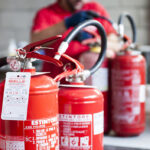Fire safety is essential for both businesses and homeowners, as it is regulated by specific laws to protect people and property. Fire extinguishers are a vital part of fire safety, serving as the first defense against small fires and helping to stop them from becoming more significant disasters. Knowing and following these laws trained by a reliable fire extinguisher company enables you to stay within legal guidelines and plays a vital role in keeping people safe and protecting property. When fire safety measures are in place, business owners and employees can feel more at ease. Taking fire safety seriously can also reduce the chances of property damage and financial loss. This article will examine the legal requirements surrounding fire extinguishers, aiming to help you maintain compliance.
Looking At The Legal Requirements for Installation
Installing fire extinguishers is not just a safety step; it’s a legal requirement in many areas. There are specific laws that explain where and how to place fire extinguishers in a building. For instance, they need to be easy to access and located close to exits so people can reach them during an emergency without blocking the escape route. Building codes and fire safety standards specify what types and sizes of extinguishers are necessary, depending on the building’s layout and what activities take place there.
Maintenance and Inspection Compliance
Regular maintenance and inspection are mandatory to ensure fire extinguishers are operational when needed. This includes routine checks by a certified local fire extinguisher service provider to verify that each unit is fully charged and functional. These inspections are documented and often required on an annual or semi-annual basis, depending on local laws. Failure to comply with these regulations can lead to fines, legal penalties, or worse, inadequate fire safety in times of need.
Training and Usage Guidelines
It’s compulsory that individuals on the premises are trained in the proper use of fire extinguishers. Legal requirements often mandate that this training be provided to ensure that everyone knows how to operate these devices effectively. This training should cover when and how to use the extinguishers, emphasizing the PASS technique, i.e., Pull, Aim, Squeeze, and Sweep. Effective training makes sure that in the event of a fire, responses are swift and competent, significantly reducing the risk of injury and property damage.
Recharging and Replacement
To remain compliant, it’s crucial to monitor the lifespan and usability of fire extinguishers. A rechargeable fire extinguisher needs periodic servicing to refill the extinguishing agent used during training or in an actual fire scenario. Furthermore, if an extinguisher reaches the end of its recommended service life or is found to be defective during an inspection, it must be replaced immediately to meet safety standards. Ensuring these units are in top condition is a legal necessity.
Final remarks
Finally, following the legal rules for fire extinguishers is essential for keeping everyone safe in any building. Regular checks, correct installation, and training for employees are key steps in ensuring a secure environment. By focusing on fire safety, you help protect lives and property while promoting a culture of readiness. If you are seeking professional services to test your fire extinguishers, then you can rely on firms like Lone Star Fire & First Aid. They provide various types of fire extinguishers suitable for your property. Also, they give quick walk-in services to reduce waiting time and ensure accurate safety measures.

